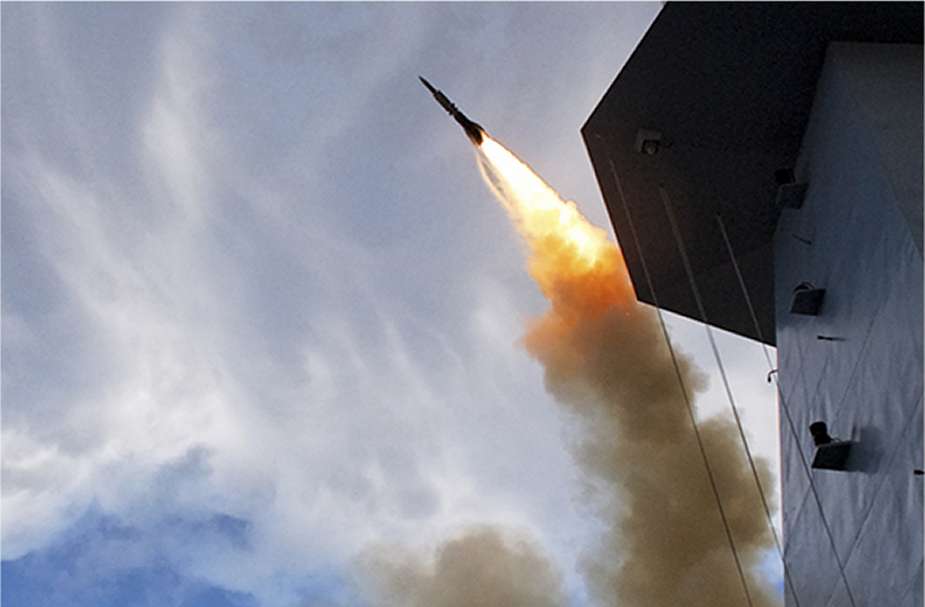Breaking news
MBDA to double the range of Aster 15 surface-to-air missiles with Aster 15 EC upgrade.
As reported by Meta Defense on April 11, 2024, the European company MBDA is set to introduce the Aster 15 EC, an update to the original Aster 15 short- to medium-range surface-to-air missile, promising to offer twice the efficiency of its predecessor. The Aster 15 was first utilized aboard the French aircraft carrier Charles de Gaulle in 2001, marking Europe's introduction to vertical launch surface-to-air missiles.
Follow Navy Recognition on Google News at this link
 The Aster missile family includes the Aster 15, designed for short to medium-range, and the Aster 30, intended for longer-range engagements. (Picture source: MBDA)
The Aster missile family includes the Aster 15, designed for short to medium-range, and the Aster 30, intended for longer-range engagements. (Picture source: MBDA)
The Aster missile family includes two models: the Aster 15, which is designed for short to medium-range, and the Aster 30, which is intended for longer-range engagements. Both models have identical missile bodies, but the Aster 30 employs a larger booster to increase its range and speed. The Aster 15 is more compact at 4.2 meters in length and lighter at 310 kg compared to the Aster 30, which weighs 450 kg and has a length of just under 5 m. Due to its larger size, the Aster 30 requires the longer tubes of the Sylver A50 or A70 vertical launching systems (VLS) for naval deployments, although it is also compatible with the American Mark 41 Vertical Launching System.
The Aster series was used effectively for the first time in naval combat in late 2023 when French Navy frigates, Languedoc and Alsace, engaged Houthi drones and missiles in the Red Sea, firing over 22 missiles. The Aster 30 missile has also been included in the SAMP/T ground-based air defense system, a system supplied to Ukraine to counter Russian missiles.
In response to advancements in comparable systems, such as the American ESSM and the Russian 9M37 Buk, which now achieve ranges of up to 50 km and beyond, MBDA has decided to upgrade the Aster 15, similar to previous enhancements seen in the Aster 30 through various block upgrades. Originally, the Aster 15 had a range of up to 30 km, modest compared to the Aster 30's capability of over 120 km.
Developed as part of a missile family initiated by France and Italy in the 1990s, the Aster 15 is capable of reaching speeds of Mach 3, and has gained recognition for its agility and ability to intercept swiftly moving and maneuverable targets, including those flying at low or steep dive trajectories. Its active radar seeker facilitates autonomous tracking of stealth targets, allowing for the simultaneous launch of multiple missiles to counter saturating attacks effectively.
In line with the evolutionary trajectory of its counterpart, the Aster 30, which has progressed into the Block 1 and Block 1 NT versions with mid-range ballistic missile defense capabilities, the Aster 15 is set to receive a significant update. This new iteration, referred to as the Aster 15 EC (Enhanced Capabilities), seeks to align with the refined threat response capabilities of the Aster 30 Block 1 NT. While maintaining the physical dimensions required for integration into existing vertical launch systems like the Sylver A43 launchers found on vessels such as the Charles de Gaulle and the first six multi-mission frigates, the upgrade aims to enhance the missile's autodirector, guidance algorithms, flight profile, and onboard computational power. These enhancements are anticipated to double the missile's range and decrease the minimum engagement distance, thereby strengthening both long-range offensive and close-range defensive capabilities.
The development of the Aster 15 EC missile will be a crucial component of the modernization initiative for the four Horizon-class air defense frigates resulting from the Franco-Italian collaboration. This modernization effort includes the upgrading of radar and combat systems to newer iterations that enhance target detection and engagement capabilities. These enhancements are slated to commence with the Italian frigates Andrea Doria and Caio Duilio in 2027, followed by the French Forbin and Chevalier Paul in 2029 and 2030, respectively, coinciding with the integration of the Aster 15 EC.
Additionally, the Charles de Gaulle aircraft carrier is scheduled for its third major technical stop in 2027, during which it will replace its existing firing installations with a new reconfigurable firing installation (ITR) specifically designed for the Aster 15 EC. This update corresponds with the replacement of the carrier's radar systems and the adoption of a centralized architecture for the combat direction system, thereby enhancing its overall self-defense capabilities.


























